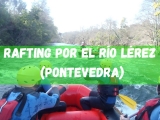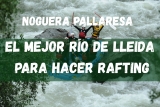IN THE ARAGONESE PYRENEES
1. Río Gállego
It is located in the town of Murillo de Gállego and has 22 kilometers for rafting. It is a tributary of the Ebro river that originates in Col d'Aneu, north of Sallent de Gállego. The classic rafting route is 11 kilometers of medium difficulty and goes from the De La Peña reservoir to the town of Murillo de Gállego. There are up to 3 different levels depending on the level of difficulty; level 1, suitable for school groups and families with children, level 2, is the most in demand for its rapids and waves, and level 3, for rafting experts.

2. Rio Veral
It begins in the town of Zuriza and runs through the Valle de Ansó until reaching the municipality of Villareal de la Canal. It is a wild and natural river that in spring, the time of thaw in the Aragonese Pyrenees, gives us the opportunity to descend large stretches with little effort, taking advantage of the flows that have melted due to the snow. It has spectacular views and vegetation that offers visitors a pleasant and peaceful time.

Access to the river is at the junction between the Hecho Valley and the Ansó Valley. Boarding takes place on the bridge Viejo, in the tributary that arrives from the port between the Hecho Valley and the Ansó Valley.
3. Aragón Subordán River
It is divided into 5 differentiated sections according to the degree of difficulty. It is located in the Valle de Hecho municipality, it is an uncomplicated stretch with privileged surroundings and views of the Hecho Valley. It has high flows and the best time of year to carry out the activity is from February to June. After the spring rains, we can find this river with a large flow of water, perfect for rafting.

It has a distance of 25 kilometers with an estimated completion time of 5 or 6 hours. The degree of difficulty is III-IV, therefore it is advisable to be at least 16 years old.
4. Ara River
It is a river limited between the Ordesa National Park and Monte Perdido, between the towns of Torla and Broto. On the descent you cross a spectacular leafy and steep canyon with a steep slope that entails great speed of water with exciting rapids.
To carry out the activity you will always be accompanied by a professional guide who will give you instructions to carry out the descent correctly. The best time to do this activity is in the months of March to July.

It has a distance of 4 kilometers, with an estimated time of 2 hours to complete the route. Boarding takes place at the Bujaruelo refuge and disembarkation takes place at the highway bridge. It has a level IV-V of difficulty.
5. Ésera River
It is located in the Benasque Valley, originates in the Maladetas Massif and flows into the Cinca River. The descent can be done at any time of the year since it has a highly regulated flow throughout the year. It is divided into two areas called "La Silla" and "Pírámides", in the latter you have to be careful because there are siphons that can be dangerous.

"La Silla" is an easy and ideal section to do with children or school groups since it has a difficulty level of 2. The "Pyramids" section has a level of difficulty of 3-4 and is aimed at people over 13 -14 years.












